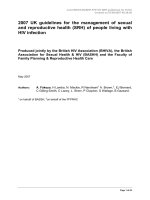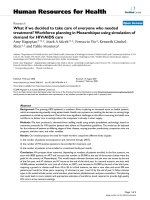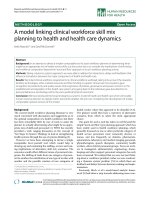Care plan
Bạn đang xem bản rút gọn của tài liệu. Xem và tải ngay bản đầy đủ của tài liệu tại đây (72.95 KB, 3 trang )
Care plan
ADD STICKER
Name:
DOB:
NHS number:
HOUDINI - make that
catheter disappear
Clinical indication
Haematuria- clots and heavy
Obstruction/catheterised by a urologist (retention) –
Bladder scan amount:
mL
Urology/gynaecology/perianal surgery/prolonged surgery
Decubitus ulcer - to assist the healing of a perianal/sacral wound in an
incontinent patient
Input/output – monitoring accurate < hourly or acute kidney injury when
oliguric
Nursing at the end of life
Immobilisation – neurogenic bladder – unstable fracture or neurological
impairment (where all other methods of toileting are contraindicated)
Other
Verbal consent given
Yes No
If unable to consent, MCA best interests completed
Yes No
Admitted with passport/existing catheter
Yes No
Patient advice leaflet given/information explained and given Yes No
Passport/card given
Yes No
Confirmed latex allergy (if yes, use all silicone catheter)
Yes No
In patients with
dementia or
delirium, always
avoid indwelling
urinary catheters –
even – if there is a
strong indication
for insertion and
consider the use
of intermittent
self/carer
catheterisation.
NA
NA
NA
NA
NA
NA
Insertion
Date and time of insertion:
Print name and role of person responsible for catheter insertion decision:
Signature:
Aseptic non touch technique used including hand hygiene
Urethral meatus/genitals cleaned with normal saline pre procedure
Foreskin replaced
Type of catheter:
Reference number:
Size:
Yes
Yes
Yes
No
No
No
NA
ADD STICKER
Always use the smallest size of catheter that will be effective. In
females insert the catheter 2.5cm beyond the point of urine flow
before inflating the balloon, to help prevent urethral trauma.
Sterile anaesthetic lubrication used
mL
Residual amount
mL
Balloon type/mL in balloon
Catheter securing device used
Drainage bag used
yes
no
type:
Date of use and expiry on catheter bag
Expected duration/date of removal
If patient has a catheter assessed as long term or retention unknown cause
then referral to other health professionals considered: yes no NA
Don’t
inflate
balloon
pre
insertion
or until
urine
drains.
No
No
No
No
No
No
No
No
No
Yes
Yes
Yes
Yes
Yes
Yes
Yes
Yes
Yes
No
Yes
No
Yes
No
Yes
No
Yes
Yes
H O U D I N I (O)
H O U D I N I (O)
No
Yes
No
Yes
No
Yes
No
Yes
No
Yes
H O U D I N I (O)
No
Yes
No
Yes
No
Yes
No
Yes
No
Yes
No
Yes
H O U D I N I (O)
No
Yes
No
Yes
No
Yes
No
Yes
No
Yes
No
Yes
H O U D I N I (O)
No
Yes
No
Yes
No
Yes
No
Yes
No
Yes
No
Yes
H O U D I N I (O)
5
Notes
6
Notes
7
Notes
8
Notes
9
Notes
10
Notes
Yes
No
Yes
No
Yes
No
Yes
No
Yes
No
Yes
No
If your patient fails a TWOC, consider teaching them or a carer intermittent selfcatheterisation.
H O U D I N I (O)
No
Yes
No
Yes
No
Yes
No
Yes
No
Yes
No
Consider planning for a TWOC to improve bladder tone consider the use of a catheter valve
to promote tone.
Yes
No
Yes
No
Yes
No
Yes
No
Yes
No
Yes
No
Patients with neurological conditions such as multiple sclerosis may need to fill their bladders
to a high capacity before they can initiate a good detrusor contraction to fully empty the
bladder. Voiding on request may result in artificially poor emptying and specialist advice may
be required.
H O U D I N I (O)
No
Yes
No
Yes
No
Yes
No
No
Yes
Patients with nocturnal polyuria may only pass small amounts of urine during the day as their
diuresis is predominantly at night. It is important that the success of the TWOC is not based
solely on bladder diaries and residual urine volumes must be considered.
Yes
No
Yes
No
Yes
No
No
If the patient is on alpha blockers for acute urinary retention, please make sure that they
have been used for the recommended period before TWOC.
Yes
Yes
ADD STICKER
When there is no longer a rationale for an indwelling urinary catheter consider a trial
without catheter (TWOC) – ensure that blood urea and electrolytes are within a normal
range for the patient prior to proceeding.
H O U D I N I (O)
Continued
Meatal cleansing
indication
(genital area)
H O U D I N I (O)
Yes
No
Trial without catheter
Day and
date
1
Notes
2
Notes
3
Notes
4
Notes
Circle your answer
Suspect a CAUTI? Don’t dipstick the urine in a patient with an indwelling
urinary catheter. Send a sample using the needle free sampling port using
ANTT. Do not use bladder washouts routinely.
Hand
Connection
hygiene
Emptied
Catheter secure, not broken
and clean
into a
bag below the
– closed
gloves
clean
bladder, tube
sterile circuit Hydration
Constipation
used
container not kinked
or valve use encouraged managed
Yes
No Yes
No
Yes
No
Yes
No
Yes
No
Yes
No
ADD STICKER
The risk of CAUTI increases 3-7% for each day the IDC remains in place.
Name:
DOB:
NHS number:
Catheters in for more than 48 hours double the chance of CAUTI.
Care plan
Name:
DOB:
NHS number:
Date of TWOC
Outcome
pass
fail
If re-catheterised was catheter passport started?
yes
no
Ensure sufficient supplies
yes
no
(for review by?)
Ensure referral to onward services
Notes:
Signature:
Designation:
Trial without catheter (TWOC) flowchart
Plan for time of removal, usually at
6am/midnight in inpatient settings or
early morning in community.
Encourage normal fluid intake (around
2L/day unless restricted). Commence an
accurate fluid balance chart.
Wait for 4-6 hours and encourage the patient to pass urine if desired.
If unable to pass urine,
check bladder volume with a
bladder scan.
If >400mL, drain
bladder with an
intermittent selfcatheter immediately.
If able to pass urine,
measure volume and record
post-void residual (PVR) record
on fluid balance/document in
community settings.
If <400mL, reassess in 1-2 hours
and encourage to
pass urine.
If residual
<400mL and patient
is comfortable,
reassess in 1-2 hours.
If residual is
>400mL, drain with
an intermittent self –
catheter immediately.
Maintain normal fluid intake and if patient voids check residual
OR
after 2 hours prompt patient to pass urine.
If unable to pass urine,
check bladder volume with
Bladder scan immediately.
If volume >400mL re–
catheterise for 5 days on free
drainage and consider care
planning options/onward
referral.
Adapted from: Yatim J,
Wong K, Ling M, Tan S,
Tan K and Hockenberry
M (2016) A nurse driven
process for timely
removal of urinary
catheters. International
Journal of Urology
Nursing 1-6.
If patient can pass urine, measure
volume and post-void residual.
If second
residual <400mL,
re-assess in 1-2
hours. Maintain
normal fluid intake.
If second residual
>400mL, drain with
an intermittent selfcatheter immediately
and re-assess in 2
hours.
If third residual
<400mL and
residual volume
is <1/3 of total
voided volume,
TWOC successful.
Discharge patient
with advice.
If third residual
is >400mL, teach
intermittent self
catheterisation if
appropriate. Recatheterise with an
indwelling urinary
catheter on 5 days free
drainage and consider
care planning options
eg use of valves to
train bladder and
improve bladder tone
or onward referral.
References can be found at









